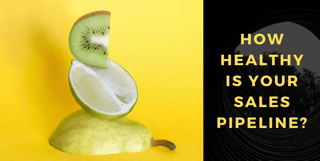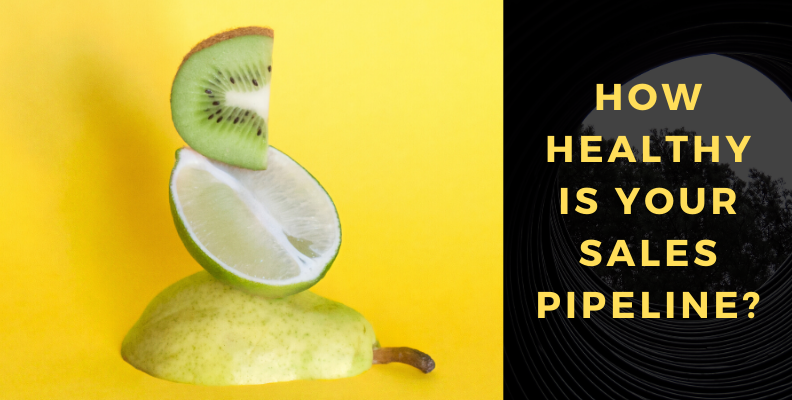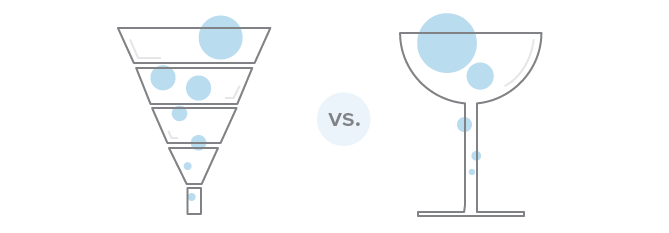

Step right up ladies and gentlemen, let’s play the numbers game! Almost anyone with sales experience knows that sales are all about the numbers. But even after sales stages and calculated conversions are defined, how do sales results change so much? It's all about the data. Crap in - Crap out! Besides asking “Are we hitting our sales target?”, how can you tell if your sales pipeline is healthy, and why is a healthy pipeline so vital to the success of the overall organizational goals?
We are all programmed to see the sales pipeline in the shape of a funnel. Cast a wide net to gather prospects and as those prospects journey through the sales process, the numbers shrink until you’re left with a small number of opportunities that are won. But is the funnel really the best way to see a sales pipeline? Really? With the most significant drop-off near the top — when a lead reaches a process milestone, like a demo or trial. This opportunity pool shouldn’t narrow much further after said milestone. This means a healthy pipeline, according to Jeff Hoffman, ("5 Questions to Assess Sales Pipeline Health", Hubspot), may look more like a champagne glass. The pipeline should indicate that once a lead passes through the qualifying stage it should be highly likely the opportunity closes. A healthy pipeline will reveal poor conversion rates early on, during qualification, in exchange for fantastic conversion rates later. https://blog.hubspot.com/sales/questions-to-assess-sales-pipeline-health
https://blog.hubspot.com/sales/questions-to-assess-sales-pipeline-health
But how do you know if your pipeline is healthy or about to hit the ER stat? Here are 5 things you can look for that can get your funnel clean and/or keep it that way.
-
Are there enough prospects at each stage of the pipeline?
If you focus all your energy on closing deals in the later stages and not ensure you're filling the funnel in the early stages, you'll be up shit's creek after you've closed all your deals focused on. Ideally, you want to move deals through each stage. This helps you understand how many deals you need in order to hit your closed-won quotas. Your stage-to-stage conversion rate is a great measure of a healthy pipeline. To find out our stage conversion rate you may want to use a tool like the "Sales Pipeline Calculator" to find the exact numbers you'll need.
-
Is the pipeline moving?
What do we mean by "moving"? A pipeline needs to flow. It's not healthy for deals to sit too long at one stage. For deals that appear stagnate, I recommend taking a hard look at the deal and determine if it's truly qualified or needs to move into another nurturing campaign. Do this for all of your "lukewarm" deals, leaving behind deals that continue to move. Don't waste any more time on deals that are stagnating.
-
Are there enough leads in the first stage to hit my target?
Let's be honest... no one wants to spend their time with leads at the top of the funnel. We all want to be closing deals. However, the top of the funnel demands special attention. If for whatever reason you run out of leads to call on - if you keep an eye on the top of the funnel, and make a list of prospects that may be in a good proposition, you will always have new leads to call on, regardless of any referrals sent your way or not. This is just good practice to keep.
-
Know which deals to focus on!
Alright, as much confidence as one can have... you won't close every deal in your pipeline. Sorry to break that to you. Experience should tell you at this point - that's not going to happen. So how do you know which deals to focus on and which to attack later? One word comes to mind... QUALIFY. Some salespeople may take a 'spray-and-pray' approach and go after everything that moves. But if you've set really strong qualification criteria, then the deals that are less likely to close should drop off before you have to decide if you need to go after it.
-
How accessible and up-to-date is your pipeline?
Many salespeople protect their pipeline like it's top-secret. A healthy pipeline should be visible and open to everyone involved in the process. It must be kept up-to-date and reviewed often. There's often a benefit to this open pipeline creating a bit of competition among salespeople, not to mention holds people more accountable to their daily activities.
Let's face it - a healthy business depends on a healthy pipeline. Tending to the sales pipeline is monumentally important to keeping it healthy. This is not something you set and forget. Taking these questions above into account helps keep your pipeline healthy and if you find it's not... It's time to take your medicine and get back on track.
